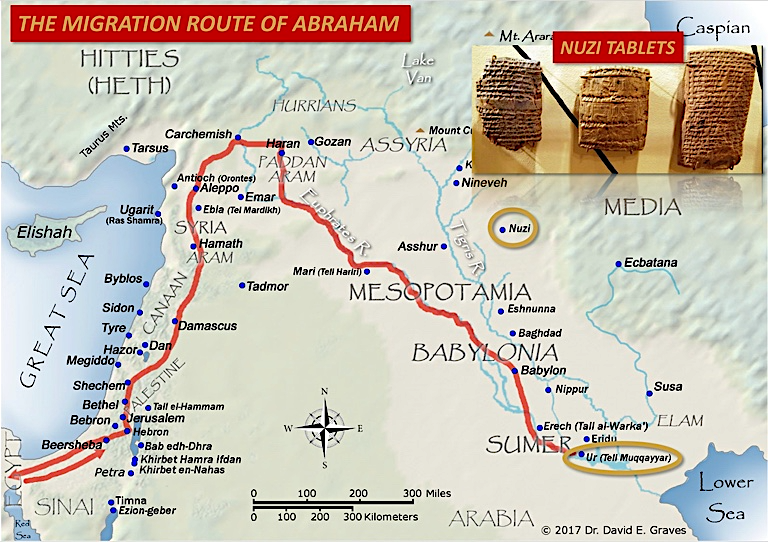"Nuzi, a mound 150 miles directly north of Baghdad, Iraq, was excavated in 1925-1931 by a joint expedition of the American School of Oriental Research in Baghdad, Harvard University, and the University of Pennsylvania Museum. Dr. Edward Chiera was the director. The soundings reached virgin soil, yet the level of occupation uncovered was the 15th to 14th centuries B.C. when the city was populated by the Hurrians, who were the long-lost Horites of the Old Testament."

"From the palace and from wealthy private homes, they recovered ~20,000 clay tablets written by Hurrian scribes in the Babylonian cuneiform lan-guage, but with the occasional employ-ment of native Hurrian (Horite) words. The tablets consisted largely of commercial accounts, contracts, reports, and judicial decisions which revealed the way of life for some leading families for four or five generations. The parallels between the customs and social conditions of these peoples and the patriarchal narratives in Genesis were not only remarkable but have proved to be one of the external factors supporting the historicity of this section of the Bible. The patriarchs came from this general section of the country, and had lived at Haran, (which was predominantly Hurrian or Horite). They had maintained contact here for generations afterward, and in the absence of laws and customs of their own (for there was, as yet, no Old Testament written), they followed those to which they had been accustomed. Notice some of the parallels:"
"(1) Exchange of Property. All transactions involving the transfer of property were recorded, witnessed, sealed, and proclaimed at the city gate (Gen. 23:10-18)."
"(2) Marriage Contracts included a statement that a handmaid could be presented to the new bride, as was the case with Leah and Rachel (Gen. 29:24, 29), and contained a provision obliging a childless wife to provide her husband with a handmaid who would bear children, as Sarah gave Hagar to Abraham (Gen. 16:3), and Rachel gave Bilhah to Jacob (Gen. 30:3-6)."
"(3) Adoption was practiced at Nuzi when a childless couple would adopt a son who would care for them while they lived, bury them when they died, and be heir to their estate. It was specified that if they ever had a son of their own, then the adopted son took second place. This seems to explain Abraham's adoption of Eliezer as his heir before the birth of Isaac, and the subsequent change when the Lord promised that a son of his own would be born to become his heir (Gen. 15:2-4)."
"(4) Birthright. A contract was found where one brother gave another 'three sheep in exchange for his inheritance share' in a plantation. This sounds like Jacob's gift to Esau of bread and a pottage of lentils (Gen. 25:30-34). Also, the 'blessing' of a dying father in bequeathing property to a son was honored in court where there was a witness to corroborate the father's words (Gen. 27:30-33, 49:1-28)."
"(5) Inheritance. In Nuzi there was a law that implied that property and leadership of the family could pass to a daughter's husband, providing the father had handed over his household gods to his son-in-law. Recall when Laban overtook Jacob and anxiously searched his camp for the household idols, and he could not find them for Rachel had taken the images [teraphim], and put them in the camel's furniture, and sat upon them (Gen. 31:34)." Chuck Missler suggested "the teraphims indicated land ownership, not so much idol worship. In case of a land dispute, the boundary markers prevailed." [2]
It is impressive that God raised Abraham within the Horite culture as a crucible for his life, leaving only specific records in scripture as an enduring teacher and pointer to Christ. When time erases America's customs away, what will be seen of God's handiwork in our lives?
[1] Description adapted from The Thompson Chain Reference Bible, 5th edition, B. B. Kirkbride Bible Co., Inc, 1988, Archaeological Supplement #4420 (p.1779-1780). Map and pix from https://biblicalarchaeologygraves.blogspot.com/2014/12/map-2.html.
[2] Source: Chuck Missler's audio studies in Genesis, https://chuckmissler.com
Like this? Consider sharing it to Facebook by clicking the linked icon below.
